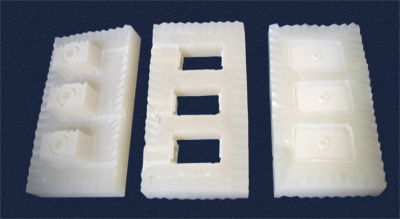Snapshot of Vacuum Casting process
What is VC (Vacuum Casting)
VC (Vacuum Casting) is typically used for casting prototypes out of polyurethane resins. The process starts with creation of master model, using various RP techniques. This master model is used to build a silicon rubber mould. Now these mould cavities are used to cast large variety of polyurethane or epoxy materials available.
Advantages of Vacuum Casting Process
- Silicone rubber tooling is a low cost solution for producing small quantity of functional parts in a short lead time.
- Large variety of urethane materials available to mimic the injection moulded materials ranging from soft rubber grades to hard plastics.
- High quality surface finish including large range of colours and textured finish available.
- Special features like Insert moulding, threaded inserts can be easily moulded inside the castings.
- Silicon moulding has distinctive advantage over hard tooling that it allows limited undercuts or negative draft angle features.
Applications of Polyurethane rubber parts
- Excellent and low cost solution for pre production release of rubber parts for Marketing, Advertisement.
- Conceptual models for effectively evaluating, optimising and communicating your design.
- Parts for Functional testing or Exhibition display purpose.
- Variable rubber hardness samples can be produced from same tooling.
- Deliver low volume production in a short lead time similar quality to injection moulded parts.
Finishing examples of PU rubber parts
Available Finishes
- Smooth Finish
- Satin finish
- Matte Finish
- Translucent Finish
Available grades of PU Rubber
| PU Rubber shore hardness | Examples |
|---|---|
25-30A
|
Rubber band, mouse pads |
40-45A
|
Pencil Eraser |
50-55A
|
Radiator hoses |
60-65A
|
Tyre Tread |
70-80A
|
Shoe sole |
80-90A
|
Skateboard Wheel |
Download
|
Download PU Reference PDF here. |
Note: above examples are for reference purpose
|
|
How Vacuum Casting process works
VC (Vacuum Casting) is widely used process in rapid prototyping industry, typically used for making 20 to 40 pieces of functional prototypes out of broad range of polyurethane resins available. The process starts with creation of an accurate and highly finished master model which can be created using various RP techniques e.g. SLA, FDM, SLS, CNC or existing part. This model is carefully placed in a mold box and liquid silicon rubber is poured over the master. After curing the silicon, mould is cut as per split line established and master model is removed, leaving an accurately formed cavities. Now these mould cavities are used to cast large variety of polyurethane or epoxy materials available. This allows fast production of high quality parts in a short lead time. A broad range of polyurethanes with various physical properties enable the production of prototypes to more closely mimic the functional properties of engineering thermoplastics.

Limitations of Vacuum Casting Process
- Vacuum Cast parts are not identical to an injection molded parts, because the conditions and method of manufacture are different.
- Single mould can make only 15 to 20 parts and most of the time need to make a new master model for next mould.
- Very thin wall sections are not recommended and chances of cracking or warping.





